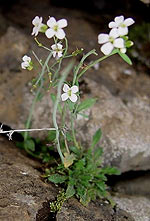Sequencing Arabidopsis lyrata and Capsella rubella, close relatives of Arabidopsis thaliana, will leverage the rich information now available for A. thaliana, arguably the most important reference plant. Arabidopsis lyrata is the closest well-characterized relative in the same genus as A. thaliana, and Capsella is the closest well-characterized genus. Several technologies are currently being used to generate a nearly complete account of intra-species polymorphisms for A. thaliana, a first for any reference organism. The value of this information will be greatly enhanced with information from close relatives.

Arabidopsis thaliana next to a wild-grown Capsella rubella plant (photo courtesy Janne Lempe)
Using closely related species for comparative analysis is essential, because plant genomes are much more dynamic than those of animals. Plant genomes undergo recurrent cycles of polyploidization and diploidization, resulting in rapid gain and loss of individual genes. Differences in the number of active genes are already known to underlie much of the adaptive variation among wild A. thaliana strains. Arabidopsis lyrata and C. rubella are close enough to A. thaliana that ancestral states of polymorphisms can be directly inferred. This greatly improves researchers’ ability to find footprints of selection and identify rapidly evolving genes. The C. rubella genome will enable scientists to determine the branch of the evolutionary tree on which differences between the two Arabidopsis species occurred.

Arabidopsis lyrata growing in its natural habitat (photo courtesy Outi Savolainen)
Arabidopsis lyrata and C. rubella are also interesting in their own right. For example, A. lyrata is an outcrossing diploid and, unlike A. thaliana, has stable and spatially restricted populations or subspecies. Thus, comparisons between A. lyrata and A. thaliana may reveal genetic changes associated with the invasive spread of A. thaliana. Similar comparisons between the diploid species C. rubella and its tetraploid sister species, C. bursa-pastoris, a globally successful invasive weed, will reinforce this investigation. Achieving a better understanding of rapid evolutionary change in plants, especially in response to human disturbance, is clearly relevant to the DOE mission. Functional information from these species will likely be directly transferable to other relevant plant species, certainly to the many heavy-metal accumulators in the same family (e.g., Arabidopsis halleri). Much of it will also apply to the fairly closely related poplar, already sequenced by the JGI.
CSP project participants: Detlef Weigel (proposer, Max Planck Institute for Developmental Biology), Joy. M. Bergelson and Justin O. Borevitz (Univ. of Chicago), Brandon S. Gaut (UC Irvine), Magnus Nordborg (Univ. of Southern California), and Stephen I. Wright (York Univ.).